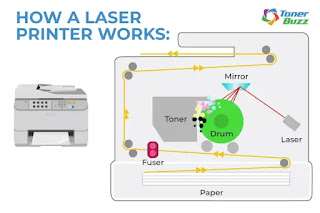What is Laser Printing Technology
Laser printing technology is a type of electrostatic digital printing. It generates high-quality text and graphics (as well as moderate-quality photographs) by passing a laser beam back and forth over a negatively-charged cylinder known as a "drum" to define a differentially-charged image. The drum then collects electrically charged powdered ink (toner) and transfers the image to paper, which is heated to permanently fuse the text, imagery, or both to the paper. Laser printers, like digital photocopiers, use a xerographic printing process. Laser printing technology differs from traditional xerography used in analog photocopiers in that the image is formed by reflecting light off an existing document onto the exposed drum in the latter.
Laser printers were invented at Xerox PARC in the 1970s and later introduced for the office and then home markets by IBM, Canon, Xerox, Apple, Hewlett-Packard, and many others. Quality and speed have increased as prices have decreased over the decades, and once cutting-edge printing devices are now commonplace.
Performance
Laser printers, like most electronic devices, have come down in price significantly over the years. The HP LaserJet, which cost $3500 in 1984 and weighed 32 kg, struggled with even small, low-resolution graphics (71 lb). Monochrome laser printers had become inexpensive enough for home-office use by the late 1990s, displacing other printing technologies, though color inkjet printers (see below) still had advantages in photo quality reproduction. Low-end monochrome laser printers can be purchased for less than $75 in 2016, and while these printers lack onboard processing and rely on the host computer to generate a raster image, they outperform the 1984 LaserJet in almost all situations.
The speed of a laser printer can vary greatly depending on a variety of factors, including the graphic intensity of the job being processed. The most powerful models can print more than 200 monochrome pages per minute. The fastest color laser printers can print at speeds of up to 100 pages per minute. In some commercial applications, very high-speed laser printers compete with lithography for mass mailings of personalized documents such as credit card or utility bills.
The cost of this technology is determined by a number of factors, including the cost of paper, toner, and drum replacement, as well as the cost of replacing items such as the fuser assembly and transfer assembly. Soft plastic drum printers can have a very high cost of ownership that is not apparent until the drum needs to be replaced.
Duplex printing (printing on both sides of the paper) can cut paper costs in half and cut filing volumes in half, albeit at a slower page-printing speed due to the longer paper path. Duplexers, which were previously only available on high-end printers, are now common on mid-range office printers, though not all printers can accommodate a duplexing unit.
External software that improves the performance and efficiency of laser printers in the workplace is becoming increasingly common in a commercial environment such as an office. The software can be used to create rules that govern how employees interact with printers, such as limiting the number of pages printed per day, limiting the use of color ink, and flagging jobs that appear to be wasteful.


